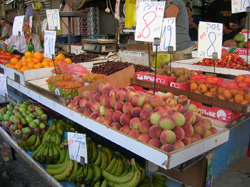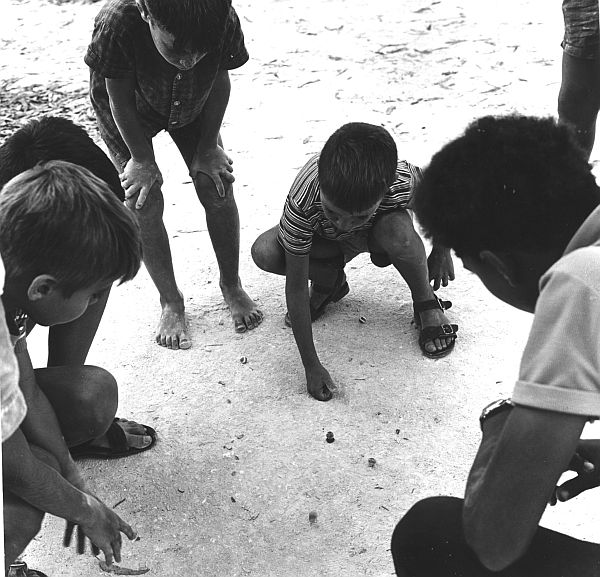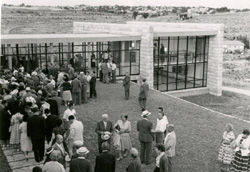Rasmī or aslī?: Arabic’s impact on Israeli Hebrew
Overview

This is a work in progress. Any suggestions, corrections, and criticisms are most appreciated. Do you have contributions to the appendix of Arabic slang in Hebrew? Click here.
Table of contents
3. Arabic loan words in Hebrew


Shehadeh has observed that most of the Arabic words in slang dictionaries are adjectives.30 This demonstrates how Arabic has provided Hebrew speakers with a colourful and innovative method of expression. Such words include: sabābāh (‘terrific’), aḥlāh (‘excellent’), aslī (‘genuine’), mabsūṭ (‘happy’), kéyf (‘fun’), ḥaflāh (‘party’), stalbeṭ (‘relaxation’), baʿsāh (or baʾsāh, ‘bummer’), fādīḥāh (‘faux pas’), fashlāh (‘screw-up’), maʿafan (‘lame’), nāḥs (‘lousy’), zīft (‘crap’), jānānāh (‘craziness’), ḥafīf (‘carelessly’), fisfūs (‘loss’), masṭūl (‘wasted, high’), zimzūm (‘hum, buzz’), nādīr (‘rare’), rasmī (‘official’), and reṣīnī (‘serious’). Other terms describe personalities, stereotypes, and emotional connexions: ṭembel (‘fool’), ahbal (‘idiot’), ʿars (‘pimp, conniving macho’), saḥbāq (‘chum’), ḥamūlāh (‘clan or extended family’), tafrān (‘pauper’), ḥabūb (‘buddy’), ʿayyūnī (‘darling’), fréḥāh (‘bimbo’), salāmtō or salāmtak (‘good guy’),
Arabic has also influenced IH greetings and interjections. Israelis greet each other with ahlān (‘hi’), call each other ḥabībī (‘my friend, dude’), urge each other on with yaʾllāh (‘come on’), and question each other with waʾllāh (‘really?’). Other common phrases include saḥtéyn (‘well done!’), be-ḥayyāt (‘for heavens sake’), ashkārāh (‘for real, truly’), maʿaléysh (‘no matter’), daḥīlaq (‘please, for goodness sake’), yaʿnī (‘that is’), ʿālek (‘yeah, right’, with sarcasm), dīr bālaq (‘watch out!’), barūd (‘heads up!’, when using explosives), and wardāh (‘ahoy!’). Some idioms, as well, mirror or even copy directly Arabic ones. As noted above, the ‘good morning’ exchange represents a Hebrew adaption of the Arabic model; in the case of the saying, yōm ʿasal, yōm baṣal (‘a honey day, an onion day’—i.e., ‘some days are good, others bad’), the Arabic phrase is imported word-for-word, no doubt owing to the phonetic similarity to Hebrew cognates. Almog has noted that thirty per cent of the Arabic words adopted into IH slang were curse words.31 Most are quite vulgar—but because they are not technically Hebrew words, speakers use them with less inhibition than if they were part of the ‘official’ lexis. A few of these swear words and insults include: īnʿal rabbāk/dīnāk/abbūk (‘curse your Lord/religion/father’), sharmūṭāh (‘slut, whore’), and a reference to the recipient’s mother, sometimes bastardised into the nonsensical kūsʾemet.
4. Conclusion: Standard vs non-standard Hebrew

In conclusion, we can observe an interesting development in the relationship between Hebrew and Arabic in the modern period. While Arabisation affected ‘official’ Mediæval Hebrew to a great extent, the ‘official’ form of MH reflects greater Western influence—in particular, the impact of SAE. However, on a non-standard, non-élite level, the penetration of Arabic has been far more extensive in contemporary Israeli Hebrew. Significantly, the use of most of these Arabic-origin words reflects a bottom-level method of entry. These borrowings are treated as foreign words; their accents remain on the original syllable and they retain initial fricatives like /f/ and /kh/, rather than conforming to Hebrew rules that demand phonetic changes, such as an initial plosive (e.g., pinjān for finjān, pashlāh for fashlāh).36 Kutscher noted, for example, that the similarly-sounding Hebrew word mukhtār (‘coronated’) differs from the loan word mukhtār (‘village chieftain’) in the plural: unlike the Hebrew mukhtārīm, the loan word mukhtārīm keeps its original stress.37 Furthermore, Arabic loan words cannot take possessive suffices—one could say mukhtāram (‘their coronated ones’), but not mukhtāram (‘their village chieftain’).38 The retention of original stress and phonetic features highlight the words’ point of origin into the Hebrew lexicon. Rather than coming through the ‘front door’ of the Academy of the Hebrew Language (as in the case of words like fālāfel, which has the normal plural of fālāfelīm), the vast majority of these other additions took place at the lips of ordinary citizens, many in the lower echelons of society. Thus, proper Hebrew reflects the European origins and Western influence of spoken the élite classes who speak the language. By contrast, sub-standard Israeli Hebrew demonstrates more local influences, as the daily interaction between Jews and Arabs has inevitably affected the idiom spoken by the society-at-large.
References and citations
- Shehadeh, ‘Influence’, 60. [↑]
- Blanc, Lāshōn, 135. [↑]
- Shehadeh, ‘Influence’, 63. [↑]
- Almog, Sabra, 199. [↑]
- Blanc, Lāshōn, 135. [↑]
- Shehadeh, ‘Influence’, 63. [↑]
- Almog, Sabra, 198. See Ben-Yehuda and Ben-Amotz, Millōn. [↑]
- Shehadeh, ‘Influence’, 63. [↑]
- Kutscher, History, 211-212. [↑]
- Ibid., 211. [↑]
- Ibid., 212. [↑]
Bibliography and further reading
Note: A large amount of literature exists on the subject of the Hebrew language, modern Israeli slang, and the interaction of Hebrew and Arabic. The bibliography below contains not only a list of works consulted in the preparation of this article, but also sources for further research on the topic.
Works consulted
Aḥīʾasaf, ʿŌdéd, et al. Leqsīqōn ha-sleng ha-ʿIvrī we-ha-ṣevāʾī [Lexicon of Hebrew and military slang]. Ramat-Gan: Prōlōg, 1993.
Almog, Oz. The Sabra: The Creation of the new Jew. S Mark Taper Foundation imprint in Jewish studies. Translated from Hebrew by Haim Watzman. Berkeley/Los Angeles/London: University of California Press, 2000.
Bar-Adon, Aaron. ‘Language planning and processes of nativization in the newly revived Hebrew’. In ha-ʿIvrīt bat-zmannénū: Meḥqārīm we-ʿiyyūnīm [Studies on contemporary Hebrew], ed. Shelomo Morag, 198–213. Vol. 1. Jerusalem: Academōn Press, 1987.
Ben-Amotz, Dahn and Netiva Ben-Yehuda. Millōn ʿolāmī le-ʿIvrīt medubberet [World dictionary of Hebrew slang]. Tel-Aviv: A Lewīn-Epshṭayn, 1972–1982.
Ben-Yehūdāh, Elīʿezer. ‘Meqōrōt: Le-malléʾ he-ḥāsér bi-leshōnénū [Sources to fill the lacunæ in our language]’. Zikhrōnōt Waʿad ha-Lāshōn 4 (1914/5674): 3–14. [online] [online (text)]
Blanc, Haim. ‘Hebrew in Israel: Trends and problems’. In ha-ʿIvrīt bat-zmannénū: Meḥqārīm we-ʿiyyūnīm [Studies on contemporary Hebrew], ed. Shelomo Morag, 155–167. Vol. 1. Jerusalem: Academōn Press, 1987.
Blanc, Haim. Lāshōn bnéy-ādām [Human language]. Jerusalem: Bialik Institute, 1989.
Blau, Joshua. The Renaissance of Modern Hebrew and Modern Standard Arabic: Parallels and differences in the revival of two Semitic languages. Near Eastern Studies, 18. Berkeley: University of California Press, 1981. [online]
Chomsky, William Zev. Ha-Lāshōn ha-ʿIvrīt be-darkhéy hitpatḥūtāh [Hebrew, the eternal language]. Sifriyyat Dānī le-maddāʿ we-haśkél, 76. Jerusalem: Rubin-Mass, 1967.
Chomsky, William Zev. Hebrew: The Eternal language. Philadelphia: Jewish Publication Society of America, 1969.
Kornblueth, Ilana and Sarah Aynor. ‘A Study of the longevity of Hebrew slang’. International Journal of the Sociology of Language 1 (1974): 15–38 (DOI 10.1515/ijsl.1974.1.15).
Kutscher, Eduard Yechezkel. A History of the Hebrew language, ed. Raphael Kutscher. Jerusalem: Magnes Press of the Hebrew University, 1982.
Morag, Shelomo, ed. Ha-ʿIvrīt bat-zmannénū: Meḥqārīm we-ʿiyyūnīm [Studies on contemporary Hebrew]. 2 vols. Jerusalem: Academōn Press, 1987.
Piamenta, Moshe. ‘Hashpāʿat ha-ʿArāvit ʿal ḥīddūshéy Ben-Yehūdāh [The Influence of Arabic on the innovations of Ben-Yehūdāh]’. Leshōnénū lā-ʿām 12.6 (118) (Nīsān–Īyyār 1961/5721): 150–158.
Rozental, Rubik. Millōn ha-sleng ha-meqīf [Dictionary of Israeli slang]. Jerusalem: Keter, 2005.
Sáenz-Badillos, Angel. A History of the Hebrew language. Translated from Spanish by John Elwolde. 1st paperback ed. New York City: Cambridge University Press, 1996.
Sappan, Raphael. ‘Hebrew slang and foreign loan words’. Ariel 25 (Winter 1969): 75–80. [online (text)]
Sappan, Raphael. Mīllōn ha-sleng ha-Yiśreʾélī [The Dictionary of Israeli slang]. Jerusalem: Qiryat-Sefer, 1965.
Shehadeh, Haseeb. ‘The Influence of Arabic on Modern Hebrew’. In Études sémitiques et samaritaines offertes à Jean Margain, ed. Christian-Bernard Amphoux, Albert Frey, and Ursula Schattner-Rieser, 149–161. Lausanne: Éditions du Zèbre, 1998.
Shehadeh, Haseeb. ‘The Influence of Arabic on Modern Hebrew’. Langues et linguistique 5 (2000): 55–66.
Wexler, Paul. The Schizoid nature of Modern Hebrew: A Slavic language search of a Semitic past. Wiesbaden: Otto Harrassowitz, 1990.
Further reading
Amara, Muhammad Hasan and Bernard Spolsky. ‘The Diffusion and integration of Hebrew and English lexical items in the spoken Arabic of an Israeli village’. Anthropological Linguistics 28.1 (Spring 1986): 43–54.
Avinery, Isaac. Kibbūshéy ha-ʿIvrīt be-dōrénū [The Achievements of modern Hebrew]. Merḥavyāh: Sifriyyat Pōʿalīm, Hotsāʾat ha-Qībbūts ha-Artsī ha-Shōmer ha-Tsāʿīr, 1946.
Bar-Adon, Aaron. ‘The Evolution of Modern Hebrew’. In Acculturation and integration: A Symposium by American, Israeli and African experts, ed. Judd L Teller, 65–95. New York City: American Histadrut Cultural Exchange Institute, 1965.
Ben-Yehūdāh, Elīʿezer. ‘Sheʾelāh lōheṭāh (nikhbedāh) [A burning (weighty) question]’. In ha-ʿIvrīt bat-zmannénū: Meḥqārīm we-ʿiyyūnīm [Studies on contemporary Hebrew], ed. Shelomo Morag, 3–15. Vol. 1. Jerusalem: Academon Press, 1987. [online (text)]
Berdichevsky, Norman. ‘The Mother of languages: The Influence of Hebrew on other languages’. Ariel 104 (1997): 6–13.
Blanc, Haim. ‘The Growth of Israeli Hebrew’. Middle Eastern Affairs 5.12 (December 1954): 385–392.
Blanc, Haim. ‘Israeli Hebrew texts’. In ha-ʿIvrīt bat-zmannénū: Meḥqārīm we-ʿiyyūnīm [Studies on contemporary Hebrew], ed. Shelomo Morag, 131–151. Vol. 1. Jerusalem: Academon Press, 1987.
Fellman, Jack, Reuven Sivan, Uzzi Ornan, et al. ‘Terūmātō shel Elīʿezer Ben-Yehūdāh li-teḥiyyat ha-lāshōn ha-ʿIvrīt [Elīʿezer Ben-Yehūdāh’s contribution to the revival of the Hebrew language]’. Qātedrāh 2 (November 1976): 81–107. [online]
Fisherman, Haya. ‘Attitudes toward foreign words in contemporary Hebrew’. International Journal of the Sociology of Language 86 (1990): 5–40 (DOI 10.1515/ijsl.1990.86.5).
Kamrat, Mordechai, Uzzi Ornan, Haim Blanc, et al. ‘ʿAl lāshōn ha-“tsabbārīm”: Wikūʾaḥ mi-sāvīv la-shulḥān ʿāgōl [On the language of the “tsabbarim” (A Round-table discussion)]’. Leshōnénū lā-ʿām 6.2–3 (1955): 3–17.
Koplewitz, Immanuel. ‘The Use and integration of Hebrew lexemes in Israeli spoken Arabic’. In Fourth international conference on minority languages, ed. Durk Gorter, 181–195. Multilingual matters, 71. Vol. 2, Western and Eastern European papers. Clevedon, UK/Bristol, Pennsylvania: Multilingual Matters, 1990.
Kutscher, Eduard Yechezkel. ‘Modern Hebrew and “Israeli” Hebrew’. Conservative Judaism 10.3 (Spring 1956): 28–45.
Morag, Shelomo. ‘Planned and unplanned development in modern Hebrew’. Lingua 8 (1959): 247–263 (DOI 10.1016/0024-3841(59)90025-7).
Shir, Semadar. Béyt-séfer zeh aḥlāh sṭūṣ [School is cool]. Tel-Avīv: Sifriyyat Maʿarīv, 1993.
Transliteration tables
For Arabic, I have chosen to conform to the basics of the system used in the International Journal of Middle East Studies, the new Encyclopædia of Islam (3rd ed.), and the Library of Congress, with two major exceptions: I always mark the tāʾ marbūṭah (ة) with an ‘h’ and I assimilate the definite article (al-) into the sun letters, both stemming from an effort to make the transliterations approximate both orthography and pronunciation.

For Hebrew transliteration, I have adopted a similar method that makes it easier to compare the two languages.

Related links
Image credits
- Artistic rendering of the Hebrew and Arabic words for ‘peace’, shālōm and salām, respectively, in a style demonstrating their graphic resemblance, against the backdrop of the Old City of Yāfō (Jaffa). Source: D Gershon Lewental (DGLnotes).
- A vegetable stall (basṭāh) at Shūq ha-Karmel (‘Carmel Market’) in Tel-Aviv. Source: D Gershon Lewental (DGLnotes).
- Children playing with marbles (jūlōt) at Qibbuts ʿEyn ha-Shofeṭ, near Ḥaifa. Source: ʿÉynhashōféṭōpedyāh.
- The inauguration of the Academy of the Hebrew Language building at the Hebrew University of Jerusalem campus on 27 May 1959. Source: Academy of the Hebrew Language.
